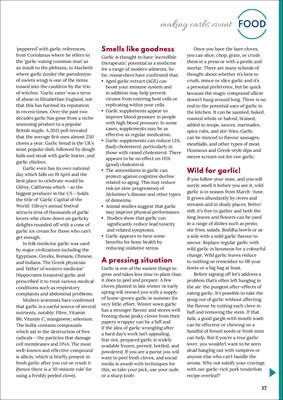
37
FOOD
making carbs count
'peppered' with garlic references,
from Coriolanus where he refers to
the 'garlic-eating common man' as
an insult to the plebians, to Macbeth
where garlic (under the pseudonym
of owlets wing) is one of the items
tossed into the cauldron by the trio
of witches. 'Garlic eater' was a term
of abuse in Elizabethan England, not
that this has harmed its reputation
in recent times. Over the past two
decades garlic has gone from a niche
seasoning product to a popular
British staple. A 2021 poll revealed
that the average Brit uses almost 250
cloves a year. Garlic bread is the UK's
most popular dish, followed by dough
balls and steak with garlic butter, and
garlic chicken.
Garlic even has its own national
day which falls on 19 April and the
best place to celebrate would be
Gilroy, California which - as the
biggest producer in the US - holds
the title of 'Garlic Capital of the
World'. Gilroy's annual festival
attracts tens of thousands of garlic
lovers who chow down on garlicky
delights rounded off with a cone of
garlic ice cream for those who can't
get enough.
In folk medicine garlic was used
by major civilizations including the
Egyptians, Greeks, Romans, Chinese,
and Indians. The Greek physician
and 'father of western medicine'
Hippocrates treasured garlic and
prescribed it to treat various medical
conditions such as respiratory
complaints and abdominal problems.
Modern scientists have confirmed
that garlic is a useful source of several
nutrients, notably: Fibre, Vitamin
B6; Vitamin C; manganese; selenium.
The bulbs contains compounds
which aid in the destruction of free
radicals - the particles that damage
cell membranes and DNA. The most
well-known and effective compound
is allicin, which is briefly present in
fresh garlic after you cut or crush it
(hence there is a '10-minute rule' for
using a freshly peeled clove).
Smells like goodness
Garlic is thought to have 'incredible
therapeutic' potential as a medicine
for a range of modern ailments. So
far, researchers have confirmed that:
• Aged garlic extract (AGE) can
boost your immune system and
in addition may help prevent
viruses from entering host cells or
replicating within your cells.
• Garlic supplements appear to
improve blood pressure in people
with high blood pressure. In some
cases, supplements may be as
effective as regular medication.
• Garlic supplements can reduce LDL
(bad) cholesterol, particularly in
those with raised cholesterol. There
appears to be no effect on HDL
(good) cholesterol.
• The antioxidants in garlic can
protect against cognitive decline
related to aging. This may reduce
risk (or slow progression) of
Alzheimer's disease and other types
of dementia.
• Animal studies suggest that garlic
may improve physical performance.
• Studies show that garlic can
significantly reduce lead toxicity
and related symptoms.
• Garlic appears to have some
benefits for bone health by
reducing oxidative stress.
A pressing situation
Garlic is one of the easiest things to
grow and takes less time to plant than
it does to peel and prepare. A few
cloves planted in late winter or early
spring will reward you with a supply
of home-grown garlic in summer for
very little effort. Winter sown garlic
has a stronger flavour and stores well.
Freeing those pesky cloves from their
papery wrapper can be a faff and
if the idea of garlic wrangling after
a hard day's work isn't appealing,
fear not, prepared garlic is widely
available frozen, pureed, bottled, and
powdered. If you are a purist you will
want to peel fresh cloves, and social
media is awash with techniques for
this, so take your pick, use your nails
or a sharp knife.
Once you have the bare cloves,
you can slice, chop, grate, or crush
them in a press or with a pestle and
mortar. There are many schools of
thought about whether it's best to
crush, mince or slice garlic and it's
a personal preference, but be quick
because the magic compound allicin
doesn't hang around long. There is no
end to the potential uses of garlic in
the kitchen. It can be sautéed, baked,
roasted whole or halved, braised,
added to soups, sauces, marinades,
spice rubs, and stir-fries. Garlic
can be minced to flavour sausages,
meatballs, and other types of meat.
Houmous and Greek-style dips and
mezes scream out for raw garlic.
Wild for garlic!
If you follow your nose, and you will
surely smell it before you see it, wild
garlic is in season from March -June.
It grows abundantly by rivers and
streams and in shady places. Better
still, it's free to gather and both the
long leaves and flowers can be used
in a range of dishes such as pesto,
stir fries, salads, Buddha bowls or as
a side with a mild garlic flavour to
savour. Replace regular garlic with
wild garlic in houmous for a colourful
change. Wild garlic leaves reduce
to nothing so remember to fill your
boots or a big bag at least.
Before signing off let's address a
problem that's often left hanging in
the air: the pungent after-effects of
eating garlic. It's possible to take the
pong out of garlic without affecting
the flavour by cutting each clove in
half and removing the stem. If that
fails, a good gargle with mouth wash
can be effective or chewing on a
handful of fennel seeds or fresh mint
can help. But if you're a true garlic
lover, you wouldn't want to be seen
dead hanging out with vampires or
anyone else who can't handle the
aroma. Why not satisfy your cravings
with our garlic-rich pork tenderloin
recipe overleaf?